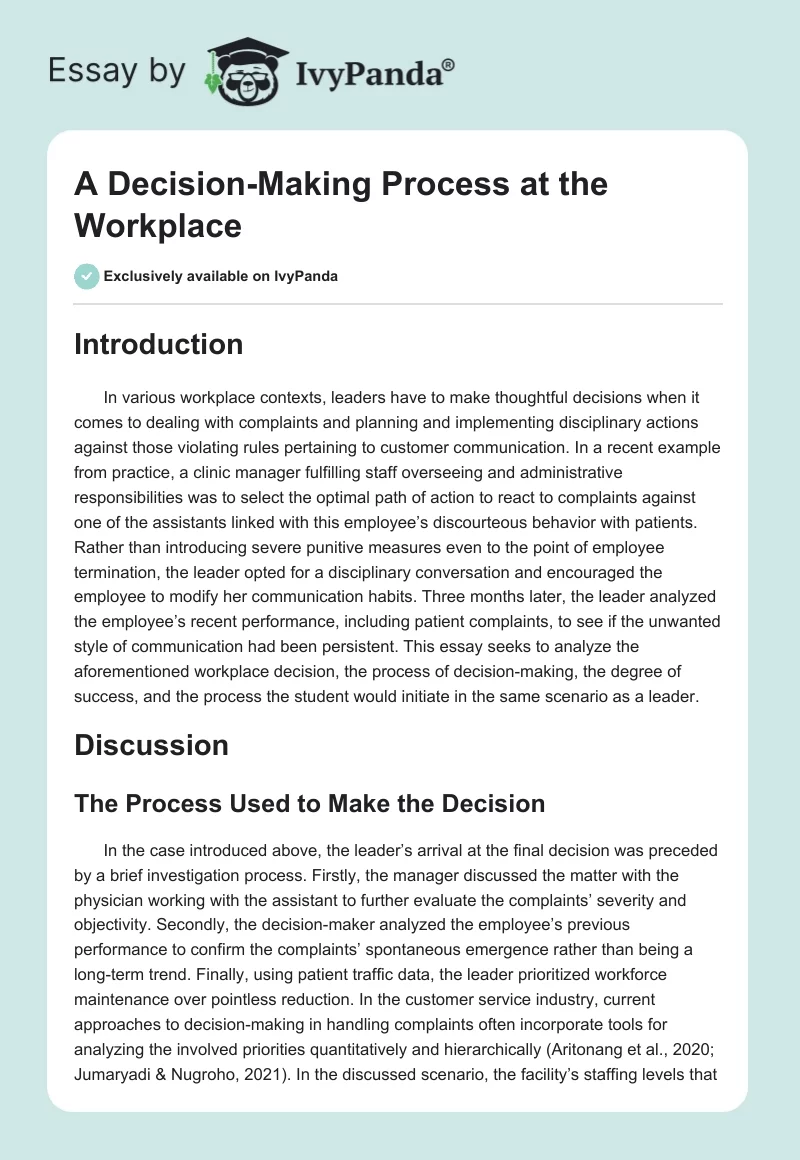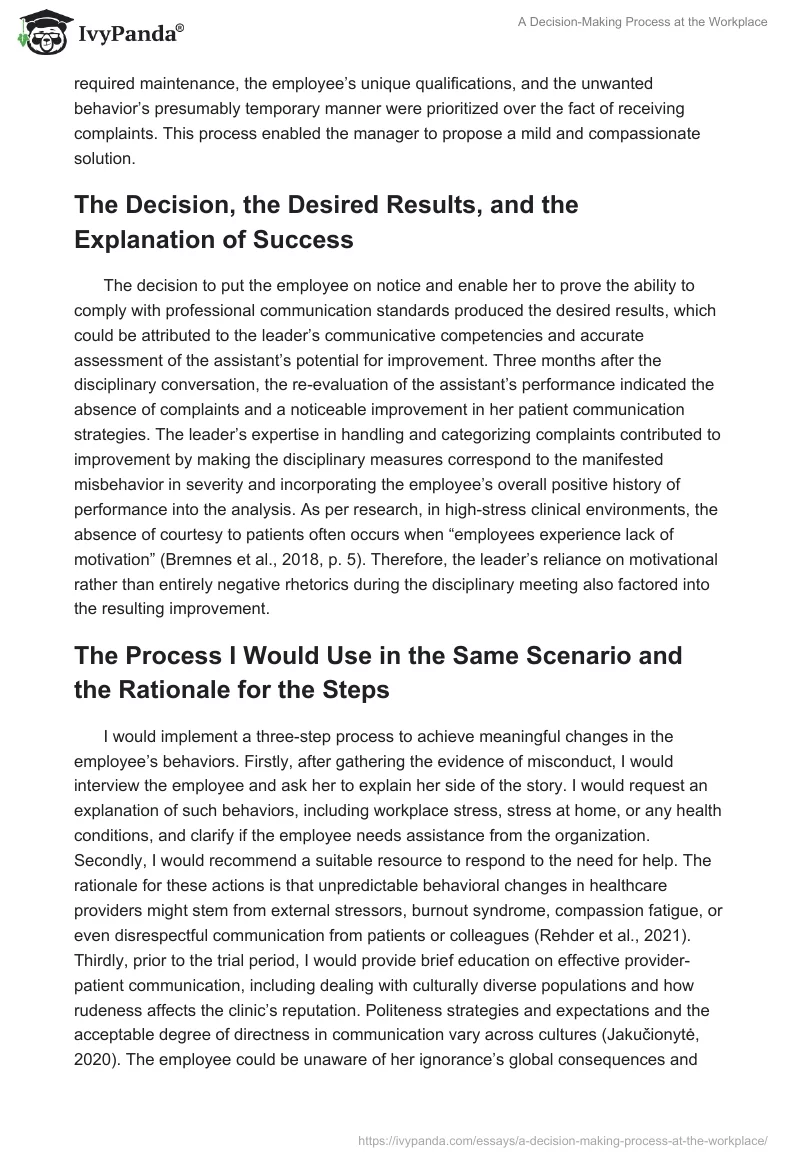Introduction
In various workplace contexts, leaders have to make thoughtful decisions when it comes to dealing with complaints and planning and implementing disciplinary actions against those violating rules pertaining to customer communication. In a recent example from practice, a clinic manager fulfilling staff overseeing and administrative responsibilities was to select the optimal path of action to react to complaints against one of the assistants linked with this employee’s discourteous behavior with patients. Rather than introducing severe punitive measures even to the point of employee termination, the leader opted for a disciplinary conversation and encouraged the employee to modify her communication habits.
Three months later, the leader analyzed the employee’s recent performance, including patient complaints, to see if the unwanted style of communication had been persistent. This essay seeks to analyze the aforementioned workplace decision, the process of decision-making, the degree of success, and the process the student would initiate in the same scenario as a leader.
Discussion
The Process Used to Make the Decision
In the case introduced above, the leader’s arrival at the final decision was preceded by a brief investigation process. Firstly, the manager discussed the matter with the physician working with the assistant to further evaluate the complaints’ severity and objectivity. Secondly, the decision-maker analyzed the employee’s previous performance to confirm the complaints’ spontaneous emergence rather than being a long-term trend. Finally, using patient traffic data, the leader prioritized workforce maintenance over pointless reduction. In the customer service industry, current approaches to decision-making in handling complaints often incorporate tools for analyzing the involved priorities quantitatively and hierarchically (Aritonang et al., 2020; Jumaryadi & Nugroho, 2021). In the discussed scenario, the facility’s staffing levels that required maintenance, the employee’s unique qualifications, and the unwanted behavior’s presumably temporary manner were prioritized over the fact of receiving complaints. This process enabled the manager to propose a mild and compassionate solution.
The Decision, the Desired Results, and the Explanation of Success
The decision to put the employee on notice and enable her to prove the ability to comply with professional communication standards produced the desired results, which could be attributed to the leader’s communicative competencies and accurate assessment of the assistant’s potential for improvement. Three months after the disciplinary conversation, the re-evaluation of the assistant’s performance indicated the absence of complaints and a noticeable improvement in her patient communication strategies.
The leader’s expertise in handling and categorizing complaints contributed to improvement by making the disciplinary measures correspond to the manifested misbehavior in severity and incorporating the employee’s overall positive history of performance into the analysis. As per research, in high-stress clinical environments, the absence of courtesy to patients often occurs when “employees experience lack of motivation” (Bremnes et al., 2018, p. 5). Therefore, the leader’s reliance on motivational rather than entirely negative rhetorics during the disciplinary meeting also factored into the resulting improvement.
The Process I Would Use in the Same Scenario and the Rationale for the Steps
I would implement a three-step process to achieve meaningful changes in the employee’s behaviors. Firstly, after gathering the evidence of misconduct, I would interview the employee and ask her to explain her side of the story. I would request an explanation of such behaviors, including workplace stress, stress at home, or any health conditions, and clarify if the employee needs assistance from the organization. Secondly, I would recommend a suitable resource to respond to the need for help. The rationale for these actions is that unpredictable behavioral changes in healthcare providers might stem from external stressors, burnout syndrome, compassion fatigue, or even disrespectful communication from patients or colleagues (Rehder et al., 2021). Thirdly, prior to the trial period, I would provide brief education on effective provider-patient communication, including dealing with culturally diverse populations and how rudeness affects the clinic’s reputation. Politeness strategies and expectations and the acceptable degree of directness in communication vary across cultures (Jakučionytė, 2020). The employee could be unaware of her ignorance’s global consequences and cultural mismatches when dealing with ethnically diverse patients. Therefore, education would be helpful to maximize the chances of success.
Conclusion
To sum up, the need to handle repetitive complaints from customers peculiar to one specific employee’s performance places leaders in a challenging situation, but the manager’s professional judgment led to the suitable decision. Giving preference to employee termination might seem an easy way to demonstrate the facility’s commitment to the principles of beneficence and patient-centeredness and instrumentalize the act of firing as a deterrent to similar acts of misconduct in other employees. However, enabling the problematic employee to demonstrate commitment might be more advantageous from a long-term perspective since it accounts for some issues’ temporary nature. Also, finding a suitable professional to replace the fired one can be more effort-intensive compared to implementing the disciplinary process and negative reinforcement. The manager’s solution effectively addressed all these factors, thus benefiting the organization.
Finally, the alternative process for achieving the desired outcome can be constructed to analyze the root cause of misbehavior. The analysis stage would center on assessing various possible reasons for communication difficulties, including occupational burnout, poor treatment in the workplace, or an insufficient understanding of politeness in various cultural contexts. By involving direct communication with the employee, the strategy would enable the leader to offer assistance or address the assistant’s knowledge deficits instead of simply restating the leadership team’s expectations.
References
Aritonang, E. D., Windarto, A. P., & Mustika, W. P. (2020). Analysis of determining customer priority complaints by using analytic hierarchy process (AHP) techniques in PDAM Tirtauli Pematangsiantar.International Journal of Information System & Technology, 3(2), 200-209. Web.
Bremnes, H. S., Wiig, Å. K., Abeid, M., & Darj, E. (2018). Challenges in day-to-day midwifery practice: A qualitative study from a regional referral hospital in Dar es Salaam, Tanzania.Global Health Action, 11(1), 1-9. Web.
Jakučionytė, V. (2020). Cross-cultural communication: Creativity and politeness strategies across cultures. A comparison of Lithuanian and American cultures.Creativity Studies, 13(1), 164-178. Web.
Jumaryadi, Y., & Nugroho, T. (2021). Implementation of simple additive weighting to determine priority for handling customer complaints.International Journal of Information System & Technology, 5(1), 17-22. Web.
Rehder, K., Adair, K. C., & Sexton, J. B. (2021). The science of health care worker burnout: Assessing and improving health care worker well-being. Archives of Pathology & Laboratory Medicine, 145(9), 1095-1109. Web.


